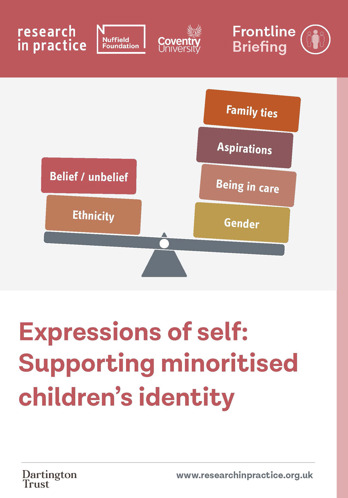Expressions of self: supporting minoritised children’s identity: Frontline Briefing (2024)
Part of Expressions of self: supporting minoritised children’s identity - open access learning resources.
Introduction
This briefing, and the tools contained within it, offer guidance on how social care practitioners can work with minoritised children and young people to explore their identities, meet their identity needs and promote positive identity development. It builds on research undertaken by Coventry University (funded by the Nuffield Foundation) regarding the identities of minoritised children and young people in care. The briefing provides tools to help social care practitioners think about and explore identity with children and young people, including:
- the different layers within their identities
- how they think, feel and relate to different aspects of their inherited identities
- how they think about their identities within different contexts, and with different people.
This is a quick-read version of Expressions of self: Supporting minoritised children’s identity: Frontline Briefing (2024), which highlights its key messages. To gain a greater understanding of the topic you can download and read the full Frontline Briefing, which includes a full list of references, case studies, further reading and useful resources suggestions, questions for reflection and example activities.
Introduction to identity
Identity can be understood as an individual’s or group’s concepts of who they are, how they define themselves, how they relate to others, and how others see them. A person’s sense of self is made up of their experiences, values, characteristics and social roles and the answers to questions such as:
- Who am I?
- What’s important to me?
- What is my place in the world?
Rather than being static, identity is fluid and reflective of social and historical contexts, which fluctuate as circumstances, contexts and personal preferences change.
Central to an understanding of identity is the term ‘intersectionality’, a framework for understanding how different aspects of identity – for example, race, gender, sexuality – can lead to experiences of inequality, disadvantage or privilege.
Identity needs of children and young people in care
According to the Care Leavers’ Charter, efforts should be made to ‘respect and honour’ a young person’s identity. Supporting children and young people’s identities can enhance their sense of wellbeing and confidence. It is important that this is a safe space for them to navigate the complexities of their circumstances and identities, and also a place where they are supported to make sense of their experiences and how these affect their identity.
Learning about identity from children and young people
The narratives of the young people who participated in the research showed that they see their identity as being defined by many experiences and beliefs, not just their ethnicity or religion.
Based on the stories and experiences of young people, the researchers developed the idea of ‘in-flux identity’, as a way of recognising that identities are layered and continually changing. Understanding children and young people’s identity as ‘in-flux’ can aid practitioners in the following ways:
- Reflects lived experience
- Avoids oversimplification
- Encourages open dialogue
- Helps prepares for challenges
- Enhances professional development.
In-flux identity has three overlapping aspects:
- Layered and intersectional
- Oscillating (changing and evolving)
- Child and young person determined.
Layered intersectional identities
Practitioners face the challenging task of striking a balance between helping young people navigate their evolving identities and ensuring all their identity needs are met, when some may not yet be fully articulated or acknowledged by the individual. It is important for practitioners to work with the child or young person to address less visible and hidden identities that may not be readily apparent to others or receive explicit recognition in their daily interactions. However, care also needs to be taken to avoid exacerbating trauma when exploring hidden identities.
It’s possible to make assumptions about identity based on what appears visible. However, these assumptions may be incorrect, simplistic, or different to how a young person sees their own identity.
Oscillating identities
Children and young people’s identities are in constant motion, adapting according to pivotal moments in their lives. This is important when considering case recording. When identities are treated as static, fixed constructs in case recordings, there is potential for children to be ascribed identities based on a particular moment in time. This can inadvertently lead to biases, misconceptions, or incomplete understandings, which might impact the quality of support they receive.
Child/young person-determined identities
Social care practitioners, as well as carers, play a key role in empowering children and young people, and supporting them to have the confidence and agency to define themselves.
In forming their identities, children and young people navigate the different cultures they encounter in care. This might include the culture of their biological family, as well as those of social workers and carers.
Children often do not conform to the rigid and set ideas of ethnic or religious identity.. Furthermore, other aspects of their identity – such as their artistic prowess – may be more important to their sense of self and wellbeing. Supporting children and young people with developing positive feelings about their identity requires practitioners to understand this as a process of co-construction. This needs to be done through building relationships with children and young people, and by checking the responsiveness of others towards them.
Conclusion
This briefing emphasises the importance of talking to children, listening to their views about their identity and then taking time to reflect on what this means for the child or young person, and the people around them.
Professional Standards
PQS:KSS - Relationships and effective direct work | Communication | Purposeful and effective social work
PCF - Diversity and equality | Intervention and skills





